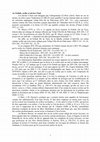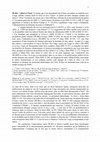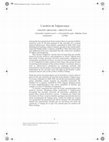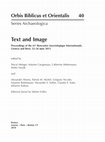Papers by Abrahami Philippe
La vie religieuse à Nuzi, 2020
Catalogue expo "Les tables du pouvoir" Louvre Lens, 2021
Atlas historique du Proche-Orient ancien (S. Sauvage éd.), 2020
Atlas historique du Proche-Orient ancien (M. Sauvage éd.), 2020

NABU 2017/2 n°52, 2017
Ar-Teššub, scribe et devin à Nuzi Les devins à Nuzi sont désignés par l'idéogramme LÚ.HAL (bārû).... more Ar-Teššub, scribe et devin à Nuzi Les devins à Nuzi sont désignés par l'idéogramme LÚ.HAL (bārû). Dans un cas au moins, on relève aussi l'indication LÚ.ME.ZU pour qualifier l'un des témoins dans un contrat de tidennūtu impliquant Tehip-Tilla fils de Puhi-šenni (JEN 305 : 15) : cette expression, surtout connue des listes lexicales comme équivalent de l'akkadien bārû (CAD B, p. 121a), pourrait correspondre à la forme LÚ.Ì.ZU qui qualifie certains des devins d'Emar (Cohen 2012, p. 118). W. Mayer (1978, p. 138, n. 1) signale un devin nommé Ar-Teššub, fils de Taya, témoin dans un échange de champs effectué par Tehip-Tilla fils de Puhi-šenni, JEN 250, l. 22 (sceau l. 26). Sa profession est notée ŠU.HAL, que W. Mayer corrige en LÚ ! .HAL. Il note, à propos de cet individu : « identisch mit dem gleichnamigen Schreiber ? ». En effet, un Ar-Teššub fils de Taya, de la famille scribale d'Apil-Sîn, est connu comme scribe par trois textes rédigés pour Tehip-Tilla fils de Puhi-šenni :

NABU 2015 2 n° 45 66-68, 2015
ŠE.BA = šibai/a à Nuzi. Ce terme qui n'est documenté qu'à Nuzi, est utilisé en relation avec l'or... more ŠE.BA = šibai/a à Nuzi. Ce terme qui n'est documenté qu'à Nuzi, est utilisé en relation avec l'orge, définie comme étant ša šibai et avec l'étain : le métal est alors désigné comme ana šibai/a 1. Pour l'essentiel, les textes qui y font référence relèvent de la documentation du palais à l'exception peut-être de HSS 13 3 (provenance inconnue) et de HSS 15 241 (=AdŠ 167) qui appartient à l'archive de Šilwa-Teššup (l. 9 : ZU-PA-e qualifiant l'orge remis à Kiltamuli, l'administrateur du domaine du prince à Pahharhe 2). L'origine hourrite du mot est envisagée par le CAD Š/3, p. 64 (« sens inconnu ») et le AHw, p. 1226b qui propose « eine Ration ? » 3. La suggestion du AHw semble assez juste au vu du parallèle entre les notices finales des listes de rationnaires HSS 16 348 et HSS 16 383 : « Ces hommes qui prendront le ši-ba-a » (HSS 16 348) et « To[tal x, ces hommes qui pre]ndront [leur] ratio[n] (ŠE.B[A-šu-nu]» (HSS 16 383). En faveur de cette hypothèse, on note aussi l'indication a-nu-u 2 ŠE.MEŠ ⌈ša ši*-ba*-i*⌉ dans HSS 14 510, r.13, une liste nominative d'une trentaine de femmes précisant le montant de leur ration : le sens d' « orge des rations » conviendrait ici tout à fait bien. De l'orge « prise sur l'orge ša šibai » (ŠE.MEŠ ša ši-ba 2-i leqû) est documentée dans deux comptes. Dans HSS 16 357, ce transfert est opéré au bénéfice de femmes (domestiques et épouses secondaires) enregistrées par leur nom dans deux groupes en fonction du montant de leur ration (1 et 2 sila 3). Dans HSS 13 172, l'orge est remise à Elhip-Tilla, sans doute le šakin bīti, et on peut supposer que l'indication ištu ŠE.MEŠ ša ši-ba 2-i ša le-qu 2-u 2 correspond, dans ce cas aussi, à un prélèvement réalisé sur les stocks destinés aux rations 4. Dans HSS 15 282, un fragment de lettre, Elhip-[Tilla], sans doute le même fonctionnaire et son collègue atuhlu, sont chargés de « faire le šibai » de 104 hommes et femmes du personnel domestique (niš bīti). Il leur est demandé pour cela de se rendre au pays de Nullu :

Le fleuve rebelle. Géographie historique du moyen Oronte Syria Supplement IV, 2016
-Parmi les lettres d'El-Amarna constituant la correspondance de l'Oronte, certaines ont été envoy... more -Parmi les lettres d'El-Amarna constituant la correspondance de l'Oronte, certaines ont été envoyées depuis des royaumes bien connus par ailleurs. C'est le cas de Qatna (EA 52-57), Qadeš (EA 189-190), Tunip (EA 59), Niya (EA 67) et du Nuhašše (EA 51). D'autres royaumes, comme Rūhizu (EA 191-192) et Labana (EA 193), ne sont pas attestés en dehors du corpus amarnien. L'article examine ces documents (toponymie/chronologie/histoire politique) ainsi que trois autres lettres rattachées à la vallée de l'Oronte dans la dernière publication en date de la correspondance d'El-Amarna que l'on doit à M. Liverani : EA 260 envoyée depuis Bīt tenni et les lettres EA 317-318. Le cadre chronologique est fixé notamment par les dates de règne des pharaons Amenhotep III (1390-1353 av. n. è.) et Akhenaton (1353-1336 av. n. è.) et du Grand Roi hittite Šuppiluliuma I (1350-1322 av. n. è.).

The Nuzi Worshop at the 55th RAI (Abrahami Lion eds) SCCNH 19, 2012
Studies on the Civilization and Culture of Nuzi and the Hurrians-19 ©2012. All rights reserved. A... more Studies on the Civilization and Culture of Nuzi and the Hurrians-19 ©2012. All rights reserved. Among the documents from Nuzi's palace there is a group of tablets found in room N 120 that pertains to the activities of a woman named Tulpun-naya. These tablets, unearthed in 1928-1929, were identified as forming a distinct dossier already in the initial publication (H. Pfeiffer and E. A. Speiser, AASOR 16, 1936). Since then, joins and additional texts have expanded this file, which now numbers 37 tablets and fragments. This dossier comprises various texts of types that are usually found in private archives: sale-adoptions in which Tulpun-naya buys plots of land, personal tidenn›tu transactions, adoptions of young girls, purchases of slaves, records of court proceedings and so on. Compared to other archives from Nuzi, this group of texts reveals the particularities of the archive-holder's economic choices, such as Tupun-naya's preference for acquiring orchards and personnel by various means. Documents pertaining to transactions undertaken by her servants were also kept in her dossier, a phenomenon known also in the archive of fiilwa-TeÍÍup.
Kakkêka rukusma HIMA 3 (Abrahami&Wolff eds), 2016
Revue internationale d'histoire militaire ancienne, n° 3, 2016 Philippe Abrahami Comptes rendus O... more Revue internationale d'histoire militaire ancienne, n° 3, 2016 Philippe Abrahami Comptes rendus Ouvrage publié avec le concours de l'École pratique des hautes études

RAI 61 OBO.SA40, 2018
Papers 19-466 Philippe Abrahami et Brigitte Lion Quelques contrats de commandes d'étoffes à Nuzi ... more Papers 19-466 Philippe Abrahami et Brigitte Lion Quelques contrats de commandes d'étoffes à Nuzi 21-31 Nikita Artemov Demonization of enemies in Mesopotamian literature A case study in verbal imagery 33-42 Mehmet-Ali Ataç Benedetta Bellucci Composite creatures on seal impressions of Nuzi Vanessa Bigot Juloux Herméneutique de l'action pour l'étude des relations entre les entités animées et leur agency au Proche-Orient ancien: Hypatia et alii Daniel Bodi The divine "image" and "shadow" in iconography, inscriptions and philology Daniel Bonneterre La cuisse de Baal Analyse d'un rituel d'intégration Sebastian Borkowski "Of marshes, kings, and rebels" On the perception and representation of southern Mesopotamian wetlands at the Neo-Assyrian royal court Manuel Ceccarelli Bemerkungen zur vermittelnden Gottheit unter besonderer Berücksichtigung der sumerischen Königshymnen Nicolas A. Corfù und Joachim Oelsner Beschriftete Hundestatuetten aus Mesopotamien 131-138 "I was swollen with hunger and he kept me alive" The imagery of the legal texts from Emar viii Jeanette C. Fincke The Nuzi apprenticeship contracts Decreeing fate and name-giving in Approaching a fundamental Mesopotamian concept with special consideration of the underlying assumptions and of the condition of possibility of human knowledge Gérard Gertoux Dating the reigns of Xerxes and Artaxerxes

What's in a Name AOAT 440 (A. G. Ventura ed.), 2018
Ancient Nuzi (present-day Yorghan Tepe) is located about 13 km away from Kirkuk, in Iraqi Kurdist... more Ancient Nuzi (present-day Yorghan Tepe) is located about 13 km away from Kirkuk, in Iraqi Kurdistan. The site was excavated during five seasons, between 1925 and 1931, by American archaeologists. Around 5000 tablets and fragments were found dating back to the end of the 15 th and to the 14 th centuries BC. Several designations of the workforce employed by palace and large households, and numerous job categories, are mentioned in these documents, especially in administrative tablets established for the management of the palace household or the assets belonging to the rich families of the town. Two studies have been devoted to specialized professions at Nuzi, by Adolf Leo Oppenheim (1939) and Walter Mayer (1978), which have already provided a comprehensive overview on most of the professions. They pertain to different sectors of activity, especially agricultural production, processing of agriculture products and food preparation, and textile production. Due to its linguistic environment, Nuzi Akkadian is permeated with an abundance of Hurrian words which are used, among other semantic categories, to characterize names of professions. Such a situation causes some difficulties in defining precisely their nature. This paper will try to clarify general designations of Nuzi workforce (§ 1), to focus then on one of these groups, the warad ekalli, "palace slaves/servants" (§ 2). The trades of people, especially those belonging to palaces and large households, were sometimes indicated, but this was by no way systematic and, in addition to that, several specialists were requested for tasks which had nothing to do with their professional skills (§ 3). We will also observe the classification of the workforce according to gender, age, and hierarchies (§ 4).
Ina mari u qan tuppi Mélanges O. Rouault, 2019
De la difficulté à établir les prix des maisons: méthodes, marchés, prix, valeur réelle, valeurs ... more De la difficulté à établir les prix des maisons: méthodes, marchés, prix, valeur réelle, valeurs vénales et incohérences variées dans la ville de Larsa paléo-babylonienne ..
Textiles in ritual uses (S. Gaspa & M. Vigo eds), 2019

Textiles and Gender in Antiquity (Harlow et. al. eds.), 2020
Bloomsbury Academic, 2021. | Includes bibliographical references and index. | Summary: "This volu... more Bloomsbury Academic, 2021. | Includes bibliographical references and index. | Summary: "This volume looks at how the issues of textiles and gender intertwine across three millennia in antiquity and examines continuities and differences across time and space-with surprising resonances for the modern world. The interplay of gender, identity, textile production and use is notable on many levels, from the question of who was involved in the transformation of raw materials into fabric at one end, to the wearing of garments and the construction of identity at the other. Textile production has often been considered to follow a linear trajectory from a domestic (female) activity to a more 'commercial' or 'industrial' (male-centred) mode of production. In reality, many modes of production co-existed and the making of textiles is not so easily grafted onto the labour of one sex or the other. Similarly, textiles once transformed into garments are often of 'unisex' shape but worn to express the gender of the wearer. As shown by the detailed textual source material and the rich illustrations in this volume, dress and gender are intimately linked in the visual and written records of antiquity. The
Les Chérubins dans l'Antiquité (P. Abrahami & S. Anthonioz eds) Kasion 6 , 2021
Hardcover Edition: ISBN 978-1-78297-631-8 Digital Edition: ISBN 978-1-78297-632-5 Hardcover Editi... more Hardcover Edition: ISBN 978-1-78297-631-8 Digital Edition: ISBN 978-1-78297-632-5 Hardcover Edition: ISBN 978-1-78297-631-8 Digital Edition: ISBN 978-1-78297-632-5








Uploads
Papers by Abrahami Philippe